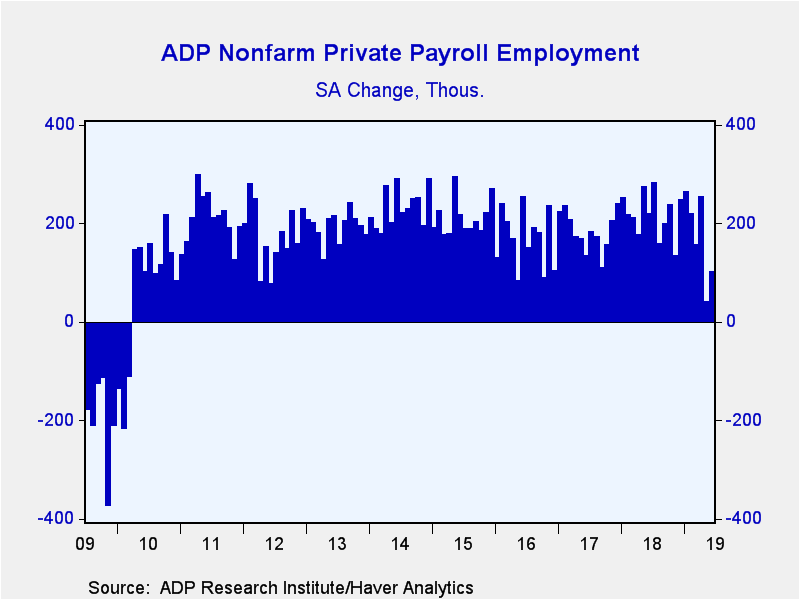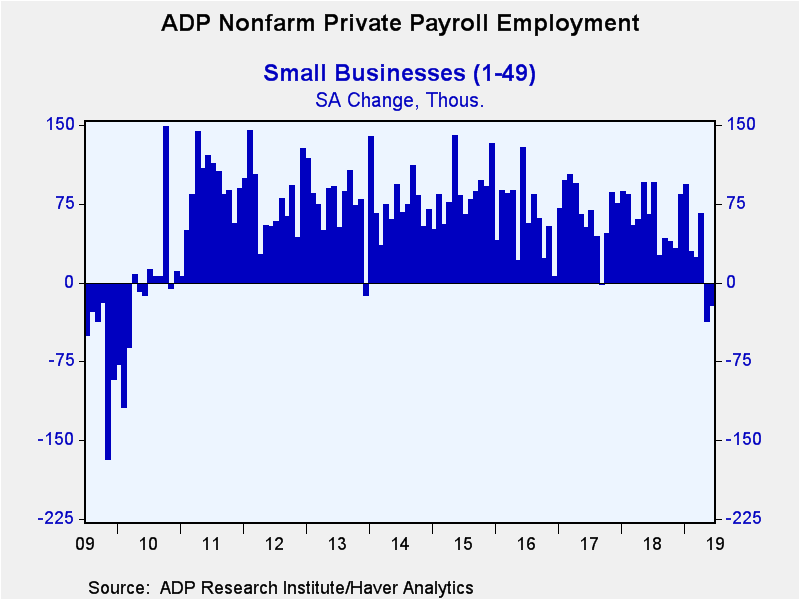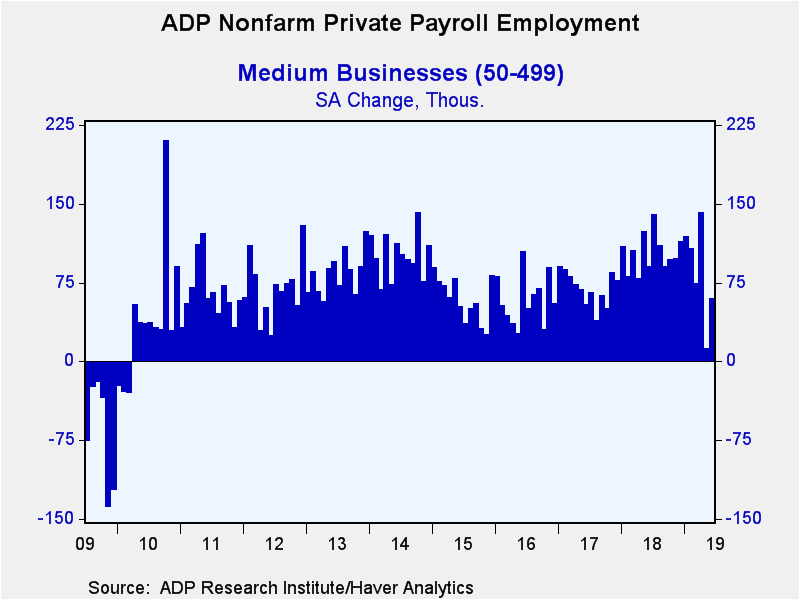 Global| Jul 03 2019
Global| Jul 03 2019U.S. ADP Private Payrolls Tick Up
Summary
The ADP National Employment Report count of private nonfarm payrolls increased a smaller-than-expected 102,000 in June (1.8% year-on-year) following an upwardly-revised 41,000 gain in May (was 27,000). The April reading was revised [...]
The ADP National Employment Report count of private nonfarm payrolls increased a smaller-than-expected 102,000 in June (1.8% year-on-year) following an upwardly-revised 41,000 gain in May (was 27,000). The April reading was revised down by 16,000, leaving net revisions at -2,000. The Action Economics Forecast Survey had anticipated a 140,000 gain. During the last three months, ADP payrolls have grown an average of 133,000 versus 214,000 in the prior three months and a 219,000 monthly average during 2018. During the last ten years there has been a 79% correlation between the change in the ADP figure and the change in nonfarm private-sector payrolls as measured by the Bureau of Labor Statistics.
Small-sized business hiring fell 23,000 in June (+0.9% y/y), the second consecutive monthly decline. Meanwhile, medium-sized payrolls grew 60,000 (2.5% y/y) and large-sized payrolls were up 65,000 (2.3% y/y).
Private service-sector payrolls increased 117,000 (1.8% y/y) driven by gains in education & health services (55,000; 2.3% y/y), professional & business services (32,000, 2.6% y/y), and trade, transportation and utilities (23,000, 1.0% y/y). Information sector payrolls declined 3,000 (+0.1% y/y), while employment in the other service sectors were up by single digits.
Employment in the goods-producing sector fell 15,000 (+1.8% y/y) in June driven by an 18,000 decline in construction sector payrolls (+2.9% y/y), the second consecutive monthly decrease. Jobs in the factory sector rose 7,000 (1.2% y/y). Lower oil prices seem to be weighing on job growth in the natural resource & mining sector, with payrolls down 4,000 (+0.8% y/y) and in four of the last five months.
The Automatic Data Processing Research Institute survey is based on ADP's business payroll transaction system covering 411,000 companies and nearly 24 million employees. The data are processed by Moody's Analytics Inc., then calibrated and aligned with the BLS establishment survey data. The ADP data cover private sector employment only.
The ADP National Employment Report data can be found in Haver's USECON database. Historical figures date back to 2001 for private employment and the industry breakdown, and 2005 for the business size breakout. The expectation figure is available in Haver's AS1REPNA database.
| ADP/Moody's National Employment Report | Jun | May | Apr | Jun Y/Y | 2018 | 2017 | 2016 |
|---|---|---|---|---|---|---|---|
| Nonfarm Private Payroll Employment (m/m chg, 000s) | 102 | 41 | 255 | 1.8 | 2.0 | 1.7 | 2.0 |
| Small Payroll (1-49) | -23 | -38 | 66 | 0.9 | 1.5 | 1.5 | 1.9 |
| Medium Payroll (50-499) | 60 | 12 | 142 | 2.5 | 2.3 | 1.8 | 1.5 |
| Large Payroll (>500) | 65 | 67 | 46 | 2.3 | 2.3 | 2.1 | 2.7 |
| Goods-Producing | -15 | -24 | 45 | 1.8 | 3.1 | 1.7 | 0.8 |
| Construction | -18 | -23 | 42 | 2.9 | 5.0 | 3.3 | 4.3 |
| Manufacturing | 7 | 2 | 6 | 1.2 | 1.8 | 0.8 | 0.1 |
| Service-Producing | 117 | 65 | 209 | 1.8 | 1.7 | 1.8 | 2.2 |
Gerald D. Cohen
AuthorMore in Author Profile »Gerald Cohen provides strategic vision and leadership of the translational economic research and policy initiatives at the Kenan Institute of Private Enterprise.
He has worked in both the public and private sectors focusing on the intersection between financial markets and economic fundamentals. He was a Senior Economist at Haver Analytics from January 2019 to February 2021. During the Obama Administration Gerald was Deputy Assistant Secretary for Macroeconomic Analysis at the U.S. Department of Treasury where he helped formulate and evaluate the impact of policy proposals on the U.S. economy. Prior to Treasury, he co-managed a global macro fund at Ziff Brothers Investments.
Gerald holds a bachelor’s of science from the Massachusetts Institute of Technology and a Ph.D. in Economics from Harvard University and is a contributing author to 30-Second Money as well as a co-author of Political Cycles and the Macroeconomy.









